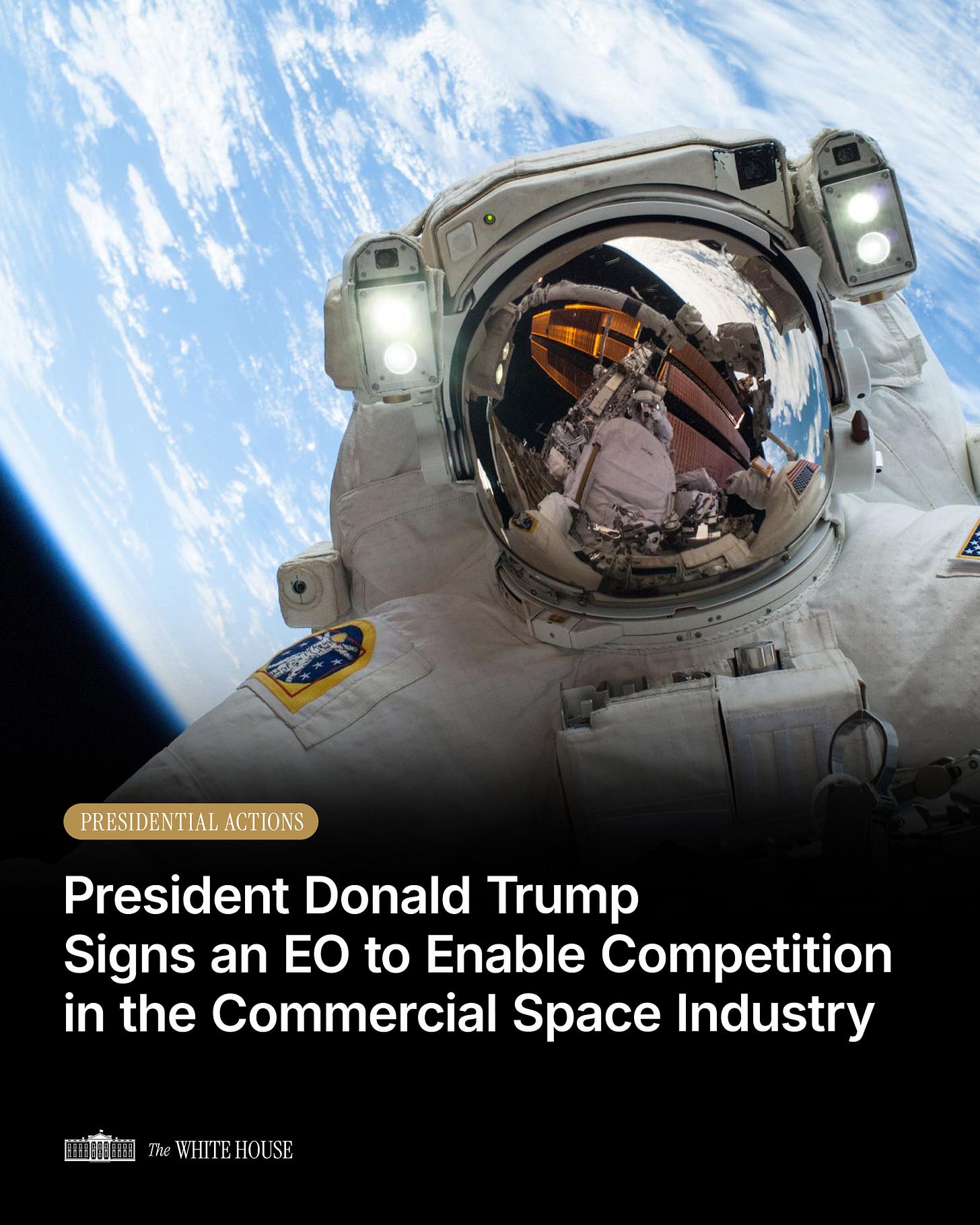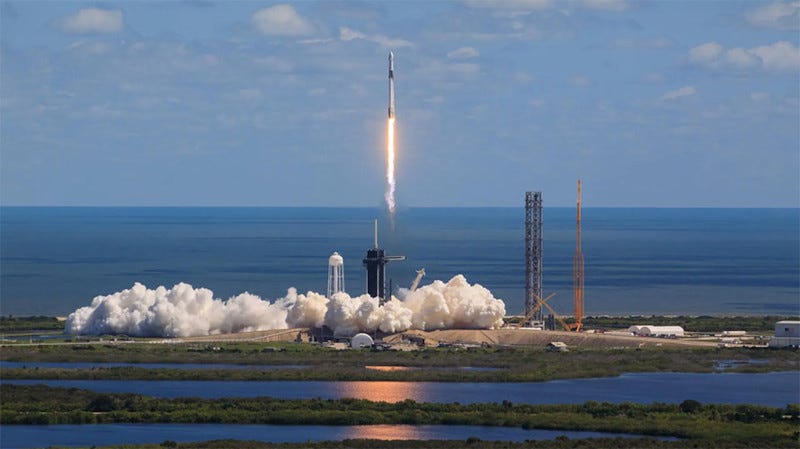President Trump's sweeping executive order on commercial space deregulation represents the most aggressive policy shift toward industry acceleration in recent memory. As regulatory barriers that historically slowed space ventures face elimination, investors and entrepreneurs confront a fundamentally altered landscape where speed-to-market advantages could determine industry leadership through 2030. The order's ambitious timeline—substantially increasing the commercial launch cadence by decade's end—transforms theoretical policy into operational reality for companies navigating capital deployment in an estimated $1.8 trillion global space economy.
The deregulation framework directly addresses bottlenecks that have constrained industry growth despite unprecedented technological advancement. Environmental review acceleration, spaceport development streamlining, and novel space activity authorization collectively target the operational friction points that separate viable business models from profitable enterprises. For institutional investors evaluating space sector allocation, these regulatory changes represent both opportunity amplification and competitive landscape disruption across multiple industry segments.
Market Dynamics and Scale
The U.S. commercial space economy demonstrated remarkable resilience and growth momentum entering 2025. SpaceX generated an estimated $13.1 billion in revenue during 2024, with projections reaching $15.5 billion for 2025—figures that would exceed NASA's entire annual budget. This growth trajectory reflects broader market expansion, with the global space economy valued at $418 billion in 2024 and forecast to reach $788 billion by 2034, representing a 6.7% compound annual growth rate.
Launch services constitute the foundational layer enabling broader space commerce. The commercial space launch market, valued at $8.2 billion in 2024, exhibits accelerating demand driven by satellite constellation deployment and emerging applications. SpaceX maintained overwhelming market dominance, conducting 87% of U.S. orbital launches in 2024 through 130+ Falcon 9 missions. This concentration reflects technological advantages in reusable rocket systems that reduce launch costs by an order of magnitude compared to traditional expendable vehicles.
Satellite manufacturing and services represent the largest revenue segment, accounting for approximately 68% of commercial space activity. Earth observation, communications, and navigation applications drive sustained demand, with small satellite deployments increasing 50% annually over the past two decades. The proliferation of low Earth orbit constellations for broadband internet, particularly SpaceX's Starlink network with 4.6 million subscribers, validates commercial viability of space-based services reaching terrestrial markets.
Investment patterns reveal both opportunity and volatility characteristic of emerging technology sectors. Total space industry investment peaked at $47 billion in 2021 before declining to approximately $8-9.5 billion annually through 2024, reflecting a broader venture capital market correction and special purpose acquisition company (SPAC) performance disappointments. However, venture capital continues to represent 51% of space company funding, indicating sustained confidence in sector fundamentals despite near-term turbulence.
Competitive Landscape and Key Players
SpaceX operates as the undisputed industry leader, leveraging an integrated business model spanning launch services, satellite manufacturing, and constellation operations. The company's $400 billion valuation reflects both operational performance and strategic positioning across multiple space economy segments. Starlink revenue reached $7.8 billion in 2024, demonstrating successful monetization of space-based infrastructure serving terrestrial customers. Launch services contributed $4.2 billion, maintaining pricing discipline while scaling operations.
Blue Origin, despite substantial backing from founder Jeff Bezos, continues pursuing catch-up positioning through heavy-lift vehicle development and suborbital tourism operations. The company's New Glenn rocket achieved initial orbital capability in January 2025, targeting 45-metric-ton payload capacity with a reusable first stage. New Shepard suborbital flights generated revenue through space tourism, completing 31 missions with 68 passengers, though commercial impact remains limited relative to orbital capabilities.
Rocket Lab established viable small satellite launch services through its Electron vehicle, conducting 63 orbital missions and delivering 190+ satellites. The company's end-to-end approach encompasses launch services, spacecraft manufacturing, and satellite components, targeting market segments requiring dedicated missions or specific orbital parameters. Neutron development targets 13-metric-ton capacity with full reusability for constellation deployment applications.
Traditional aerospace prime contractors including Boeing, Lockheed Martin, and Northrop Grumman maintain significant market positions through government contracts and satellite manufacturing capabilities. United Launch Alliance's Vulcan rocket provides heavy-lift capability for national security missions, though at substantially higher per-launch costs than reusable alternatives.
Emerging competitors including Virgin Galactic, Firefly Aerospace, and Relativity Space pursue differentiated market positioning through specialized capabilities or cost structures. However, achieving sustainable profitability against established players requires technological differentiation or niche market focus given incumbent advantages in manufacturing scale and operational experience.
Application Sectors and Use Cases
Earth observation represents the most mature commercial space application, with the broader satellite data services market valued at $9.3 billion in 2023. Maxar Technologies and Planet Labs monetize satellite data for agriculture optimization, urban planning, environmental monitoring, and national security applications. Artificial intelligence integration transforms raw satellite imagery into actionable intelligence, expanding addressable markets beyond traditional government customers.
Satellite communications maintains the largest revenue base, supporting telecommunications infrastructure, maritime connectivity, and internet services. SES, which completed acquisition of Intelsat in July 2025, faces competitive pressure from low Earth orbit constellations offering lower latency and global coverage. SpaceX's Starlink captured significant market share through aggressive pricing and rapid deployment, forcing industry restructuring.
Space tourism emerges as a high-visibility but limited-scale application. Blue Origin's suborbital flights command premium pricing for brief weightlessness experiences, while orbital missions cost $50-60 million per seat. Market expansion requires substantial cost reduction and safety demonstration, with the addressable market constrained by extreme pricing relative to terrestrial alternatives.
In-space manufacturing and asteroid mining represent emerging applications with transformative potential but uncertain timelines. Redwire (formerly Made In Space) and Varda Space have demonstrated orbital manufacturing capabilities for pharmaceuticals and advanced materials production. Regulatory clarity through streamlined novel space activity authorization could accelerate these ventures by reducing development uncertainty.
Space-based solar power and orbital infrastructure remain largely conceptual but attract venture capital investment based on long-term energy market potential. Space Solar and similar ventures will require breakthrough cost reductions and technological advancement before achieving commercial viability.
Executive Order Impact Analysis by Sector:
Earth observation companies gain significant advantages through expedited environmental reviews and launch licensing. Maxar Technologies and Planet Labs can deploy constellation refreshes and expansion satellites faster, maintaining competitive imagery resolution and revisit times. Reduced regulatory lag enables rapid response to customer demands for specific geographic coverage or temporal frequency.
Satellite communications operators experience mixed impacts. The newly merged SES (which acquired Intelsat in July 2025) benefits from streamlined replacement satellite launches but faces intensified competition, as SpaceX's Starlink can deploy additional capacity more rapidly. The order's spaceport development provisions particularly favor constellation operators requiring a high launch cadence.
Space tourism ventures receive substantial regulatory tailwinds. Blue Origin's New Shepard operations benefit from reduced flight termination system requirements and waived regulations for hybrid vehicles with airworthiness certificates. However, safety perception risks increase if accident rates rise under relaxed oversight, potentially damaging the nascent tourism market's public acceptance.
In-space manufacturing and asteroid mining represent the order's biggest beneficiaries through Section 5's novel space activity authorization framework. Redwire and Varda Space gain defined regulatory pathways with "definitive timelines" for approval, reducing investment uncertainty that has constrained venture capital deployment. This clarity could accelerate development by 2-3 years compared to previous regulatory ambiguity.
Space-based solar power ventures like Space Solar benefit indirectly through faster spaceport development and streamlined launch approvals for demonstration missions. However, these remain early-stage technologies where regulatory speed provides limited advantage compared to fundamental technical and economic challenges requiring breakthrough innovation.
Investment Implications and Future Outlook
The deregulation executive order creates immediate competitive advantages for companies capable of rapid expansion. Environmental review acceleration enables faster launch site development and mission deployment, particularly benefiting operators with existing capabilities seeking scale increases. SpaceX's operational momentum positions the company to capture disproportionate benefits from regulatory streamlining, potentially accelerating Starship deployment and Mars mission development.
Spaceport infrastructure development presents significant capital deployment opportunities as facility construction accelerates under streamlined approval processes. Private spaceport operators including Spaceport America and emerging facilities in Texas, Virginia, and California could experience increased utilization and revenue growth. Construction and engineering firms specializing in aerospace infrastructure represent indirect investment exposure.
Novel space activity authorization creates regulatory clarity enabling venture capital deployment in previously uncertain applications. Asteroid mining, orbital manufacturing, and space-based energy ventures gain defined pathways to operational approval, reducing development risk and potentially accelerating private investment. Companies demonstrating early technical progress could achieve significant valuation increases as regulatory uncertainty diminishes.
Launch service pricing pressure intensifies as capacity expansion outpaces demand growth. SpaceX's aggressive pricing strategy for rideshare missions forces competitors toward niche market positioning or operational efficiency improvements. Rocket Lab and emerging small launch providers must demonstrate sustainable unit economics against incumbent cost advantages.
The 2030 timeline creates urgency around commercial space capabilities that could reshape competitive positioning. Companies achieving technological breakthroughs in reusable systems, in-space operations, or novel applications could capture outsized market share during this expansion phase. However, capital intensity and technical risk require careful due diligence around execution capabilities and market timing.
Market consolidation appears likely as venture capital deployment becomes more selective following recent investment corrections. Companies with limited runway or unproven business models face acquisition or failure, while established players with operational capabilities and customer relationships maintain funding access. Strategic acquirers from adjacent industries may enter space markets through targeted transactions.
Conclusion
Commercial space deregulation represents a calculated bet on American technological leadership and entrepreneurial capability. The executive order's aggressive timeline aligns regulatory frameworks with the industry’s operational pace, potentially accelerating innovations that have struggled with bureaucratic constraints. For investors, this creates both opportunity amplification and increased competitive intensity requiring sophisticated market analysis and company evaluation.
The space economy's expansion toward $1.8 trillion by 2035 depends critically on achieving cost reductions and operational reliability that transform space access from exceptional to routine. Companies demonstrating sustainable business models, technical differentiation, and operational excellence during this regulatory transition could establish enduring competitive advantages. However, the capital-intensive nature of space ventures and inherent technical risks demand careful portfolio construction and realistic timeline expectations.
The deregulation framework ultimately tests whether reduced government oversight accelerates innovation or compromises safety and environmental protection. Success metrics include launch cadence increases, cost reductions, and new application development without major incidents that could trigger regulatory reversal. Stakeholders must balance growth opportunity against operational prudence in pursuing America's space economy leadership.
Editorial Notes
Sources:
Payload Space: SpaceX revenue analysis and industry forecasting
Space Capital: Investment trend analysis and market data
Grand View Research: Space technology market sizing and projections
World Economic Forum: Space economy outlook and applications analysis
McKinsey: Space investment strategies and competitive dynamics
NASA and Commerce Department: Government space policy and statistics
Verification Limitations:
Private company financial data not independently auditable
Future market projections subject to technological and regulatory uncertainty
Investment figures vary between research sources due to definitional differences
Real-time policy impact assessment limited by recent executive order timing
Research Gaps:
Limited granular data on small-scale space companies
Incomplete international competitive analysis beyond U.S. focus
Regulatory implementation timeline uncertainty
Long-term sustainability analysis of current business models
IMPORTANT DISCLAIMER: This article is for informational and educational purposes only and does not constitute investment advice, financial advice, or a recommendation to buy, sell, or hold any securities. The information presented is based on publicly available data and should not be relied upon for making investment decisions. All investments carry risk, including the potential loss of principal. Readers should conduct their own research and consult with qualified financial advisors before making any investment decisions. Past performance does not guarantee future results. The authors and publishers are not licensed financial advisors and assume no liability for any financial losses that may result from the use of this information.
This article was produced with the assistance of A.I.









